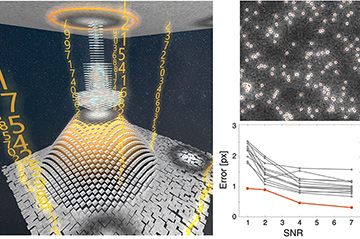 Left: Using a convolutional neural network, DeepTrack determines the exact position of a microscopic particle, outperforming standard algorithms. Top right: Example of particles tracked (orange dots) in a very noisy environment. Bottom right: When benchmarked against a wide range of particle-tracking methods based on algorithmic approaches (gray lines; details in reference 3), DeepTrack (orange line) outperformed all of them for all considered signal-to-noise ratios (SNRs). [Enlarge figure]
Left: Using a convolutional neural network, DeepTrack determines the exact position of a microscopic particle, outperforming standard algorithms. Top right: Example of particles tracked (orange dots) in a very noisy environment. Bottom right: When benchmarked against a wide range of particle-tracking methods based on algorithmic approaches (gray lines; details in reference 3), DeepTrack (orange line) outperformed all of them for all considered signal-to-noise ratios (SNRs). [Enlarge figure]
Particle tracking is a key enabling technology for diverse applications. The motion of a microscopic particle often serves as a local probe of its surrounding microenvironment—for example, to measure biomolecular forces, to explore the rheology of complex fluids, to monitor the growth of colloidal crystals and to determine the microscopic mechanical properties of tissues. This year, we introduced a deep-learning approach to particle tracking that could boost its reliability and usefulness in many of these areas.
Introduced about 20 years ago,1 digital particle tracking today remains dominated by algorithmic approaches, which require the user to provide explicit rules for processing a particle’s image to obtain its position. Some of the most commonly employed algorithms work by calculating the centroid of the particle after thresholding the image to convert it to black and white1 or by calculating of the radial-symmetry center of the particle.2
The performance of these approaches degrades severely at low signal-to-noise ratios (SNRs) and under unsteady or inhomogeneous illumination. This often requires significant intervention by the user to reach an acceptable performance, which in turn introduces user bias. In practice, in these conditions, scientists must manually search the space of available algorithms and parameters, a process that is often laborious, time-consuming and user-dependent. This has severely limited the uptake of particle-tracking methods outside of specialized research labs, and has also led to a flourishing of research activity devoted to comparing their performance in challenging conditions.3
To overcome these limitations, we recently introduced a data-driven approach to particle tracking, based on a convolutional neural network, that we named DeepTrack.4 A fully automated deep-learning network design, DeepTrack achieves subpixel resolution for a broad range of particle types, even in the presence of noise and under poor, unsteady illumination conditions, significantly outperforming standard algorithms. We have also provided a free Python software package5 that can be readily personalized and optimized for the needs of specific users and applications.
We believe that this work represents a paradigm change in how single-particle tracking is performed, and that it can accelerate the development of particle-tracking techniques capable of operating with high reliability for applications in biomedicine, biophotonics, physics, biology and engineering.
Researchers
Saga Helgadottir, Aykut Argun and Giovanni Volpe, University of Gothenburg, Gothenburg, Sweden
References
1. J.C. Crocker and D.G. Grier. J. Colloid. Interface Sci. 179, 298 (1996).
2. R. Parthasarathy. Nat. Methods 9, 724 (2012).
3. N. Chenouard et al. Nat. Methods 11, 281 (2014).
4. S. Helgadottir et al. Optica 6, 506 (2019).
5. S. Helgadottir et al. DeepTrack v1.0, https://github.com/softmatterlab/DeepTrack
